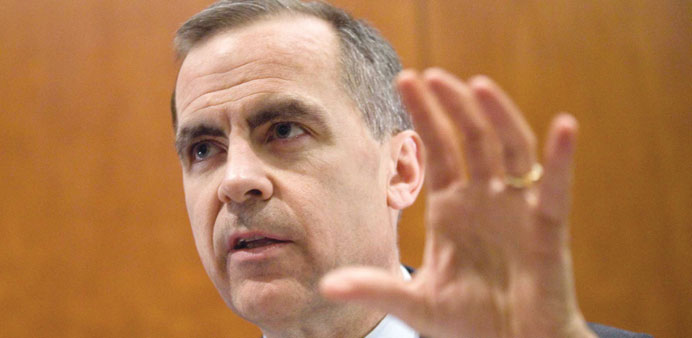The Bank of England broke with tradition yesterday, saying it planned to keep interest rates at a record low until unemployment falls to 7% or below, which it views as unlikely for another three years.
But its attempt to steer expectations about future rate moves and bolster a fledgling economic recovery underwhelmed investors who brought forward expectations for when rates would rise from a record low — the opposite of what the central bank was hoping for.
New BoE Governor Mark Carney said a recovery in Britain’s economy was underway and appeared to be broadening but had a long way to go.
“We’re not at escape velocity right now,” he said at his first BoE news conference. “This remains the slowest recovery in output on record.”
The Bank said it would consider raising rates if the public’s medium-term inflation expectations rise dangerously high; if it forecasts that inflation in 18-24 months will be at 2.5% or higher; or if ultra-low rates pose a threat to financial stability, possibly a nod to Britain’s housing market.
Economists said those caveats raised questions about how long the forward guidance was good for and could make it harder to understand for households and businesses who the Bank wants to reassure that borrowing costs will not be rising any time soon.
Carney suggested to reporters he was not concerned with signs of a recovery in property prices.
The US Federal Reserve last year launched a similar plan to keep its interest rates near zero until unemployment falls to 6.5% or inflation expectations top 2.5%.
“The forward guidance contained in the inflation report was broadly expected but what was unexpected were the get-out clauses,” said Lena Komileva at consultancy G+ Economics. “The BoE’s pre-commitment to keeping rates at a record low is not as conclusive as it first appeared.”
Carney took over as BoE governor last month, having helped steer his native Canada through the fallout from the financial crisis in 2009 by pledging to keep interest rates low for more than a year.
At the time of his appointment earlier this year, Britain’s economy was struggling to show any growth at all. Since then, however, a string of surprisingly strong economic indicators have suggested the country is already on the way to recovery.
Carney said the aim of the guidance plan was aimed to serve as a clarification about the Bank’s attempts to help revive the economy, rather than serve as a new stimulus itself.
Adding to the challenge for Carney, some other top policymakers at the BoE have previously expressed concern about tying their hands on monetary policy and potentially risking the Bank’s inflation-fighting credibility.
Carney declined to answer a question at the news conference as to whether the nine-member Monetary Policy Committee, which he chairs, had backed the guidance plan unanimously.
Finance Minister George Osborne, who wants “monetary activism” to offset his fiscal austerity push, welcomed the plan and said it was consistent with the government’s “absolute commitment” to Britain’s 2% inflation target.
The BoE’s policymakers said they stood ready to buy more government bonds if additional stimulus was needed and would not reverse existing purchases while unemployment was too high.
The central bank said inflation was forecast to stay above its 2% target until the second half of 2015 based on market rate expectations.
It said Britain’s economy had strengthened over the past three months. But output still remains more than 3% below its pre-crisis peak, a much weaker recovery than in the US or Germany.
The central bank now forecasts the economy will grow 0.6% during the current quarter — the same as between April and June, and that growth will reach an annual rate of 2.6% in two years’ time, compared with 2.2% forecast three months ago, assuming interest rates stay on hold.
Unemployment is expected to fall only slowly from its current level of 7.8% of the workforce, with the central bank expecting it to average 7.1% in the third quarter of 2016, the end of its forecast horizon.
This implies that the BoE expects to keep interest rates unchanged until at least that time, unless one of three conditions is breached before then.
But if the recent spurt of strong economic data persists, the jobless rate could fall significantly faster.
“The threshold target for unemployment was higher than the market was expecting and the market’s perception was that if the economy recovers then rates might rise sooner,” said Paul Robson, currency strategist at RBS, after sterling was propelled to a one-and-a-half-month high.
Inflation is forecast to average 2.9% in the last three months of this year — close to its current level and a lower peak than previously thought — and then to fall roughly as predicted three months ago, hitting the 2% target in mid-2015.



